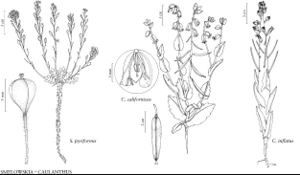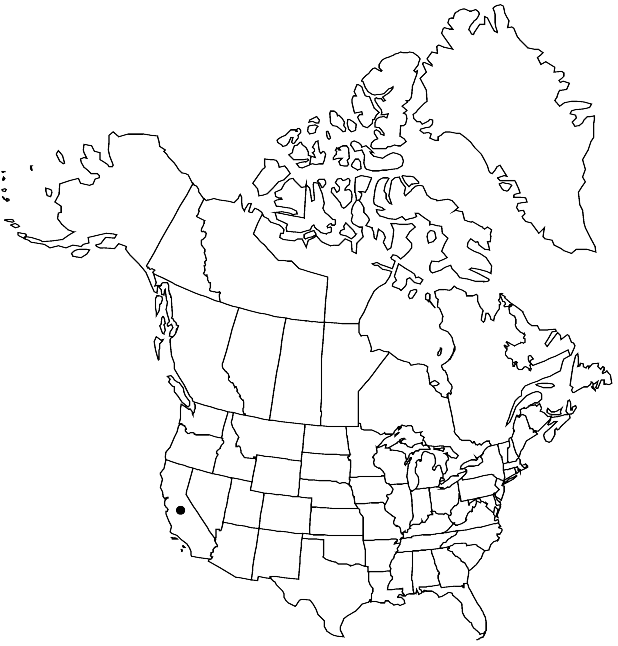Difference between revisions of "Caulanthus californicus"
Ann. Missouri Bot. Gard. 9: 299. 1923.
FNA>Volume Importer |
FNA>Volume Importer |
||
| Line 10: | Line 10: | ||
|name=Stanfordia californica | |name=Stanfordia californica | ||
|authority=S. Watson | |authority=S. Watson | ||
| + | |rank=species | ||
|publication_title=in W. H. Brewer et al., Bot. California | |publication_title=in W. H. Brewer et al., Bot. California | ||
|publication_place=2: 479. 1880 | |publication_place=2: 479. 1880 | ||
| Line 16: | Line 17: | ||
|name=Streptanthus californicus | |name=Streptanthus californicus | ||
|authority=(S. Watson) Greene | |authority=(S. Watson) Greene | ||
| + | |rank=species | ||
}} | }} | ||
|hierarchy=Brassicaceae;Brassicaceae tribe Thelypodieae;Caulanthus;Caulanthus californicus | |hierarchy=Brassicaceae;Brassicaceae tribe Thelypodieae;Caulanthus;Caulanthus californicus | ||
| Line 40: | Line 42: | ||
-->{{#Taxon: | -->{{#Taxon: | ||
name=Caulanthus californicus | name=Caulanthus californicus | ||
| − | |||
|authority=(S. Watson) Payson | |authority=(S. Watson) Payson | ||
|rank=species | |rank=species | ||
| Line 55: | Line 56: | ||
|publication year=1923 | |publication year=1923 | ||
|special status= | |special status= | ||
| − | |source xml=https://jpend@bitbucket.org/aafc-mbb/fna-data-curation.git/src/ | + | |source xml=https://jpend@bitbucket.org/aafc-mbb/fna-data-curation.git/src/f50eec43f223ca0e34566be0b046453a0960e173/coarse_grained_fna_xml/V7/V7_1165.xml |
|tribe=Brassicaceae tribe Thelypodieae | |tribe=Brassicaceae tribe Thelypodieae | ||
|genus=Caulanthus | |genus=Caulanthus | ||
Revision as of 22:12, 16 December 2019
Annuals; (sometimes glaucous), hispid proximally, glabrous distally. Stems erect to subdecumbent, usually branched distally, 0.9–5.5 dm, sparsely hispid basally. Basal leaves rosulate; petiole 0.3–3.5 cm; blade oblanceolate, 0.7–8 cm × 3–25 mm, margins often coarsely dentate, sometimes somewhat pinnatifid. Cauline leaves (median) sessile; blade oblong or suborbicular to obovate, 0.6–7.5 cm × 3–55 mm (smaller distally, base amplexicaul), margins coarsely dentate or entire. Racemes (densely flowered), with a terminal cluster of sterile flowers. Fruiting pedicels ascending to reflexed, 2–11 mm, usually pubescent, rarely glabrous. Flowers: sepals erect to ascending (dark purple in bud, purplish green after anthesis), ovate-lanceolate, 4–9(–11) × 2.5–3.5 mm (unequal, adaxial one longest, keeled); petals white (with purple veins), 5.5–12 mm, blade 2–5 × 1–2 mm, crisped, claw narrowly oblong to lanceolate, 5–8 × 2.5–4 mm; filaments in 3 unequal pairs, abaxial pair 3–8 mm, lateral pair 2–7 mm, adaxial pair (connate), 5–9 mm; anthers oblong, equal, 1–3.5 mm. Fruits erect or reflexed (often straight), angustiseptate, 1.7–5 cm × 3.5–6 mm; valves each with prominent midvein; ovules 46–100 per ovary; style 0.2–2.7 mm; stigma strongly 2-lobed (lobes to 2 mm, opposite valves). Seeds (subglobose, plump), 1–1.6 mm diam., (cotyledons deeply 3-fid). 2n = 28.
Phenology: Flowering Feb–Apr.
Habitat: Grasslands, juniper woodlands
Elevation: 100-1000 m
Discussion
According to R. E. Buck (1995), the range of Caulanthus californicus was highly reduced from conversion of habitats into agricultural land, and it is now restricted to portions of Fresno, Santa Barbara, and San Luis Obispo counties, whereas its previous range included also Kern, Kings, Monterey, Tulare, and Ventura counties.
Selected References
None.

